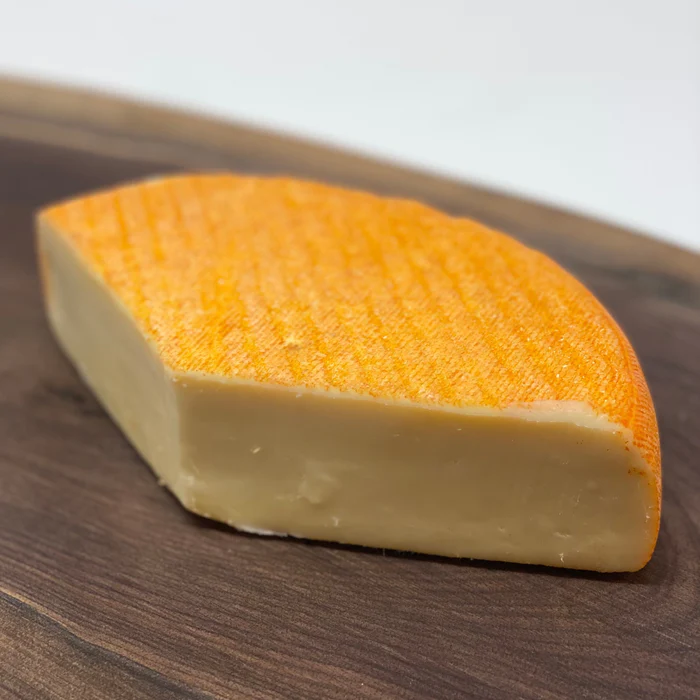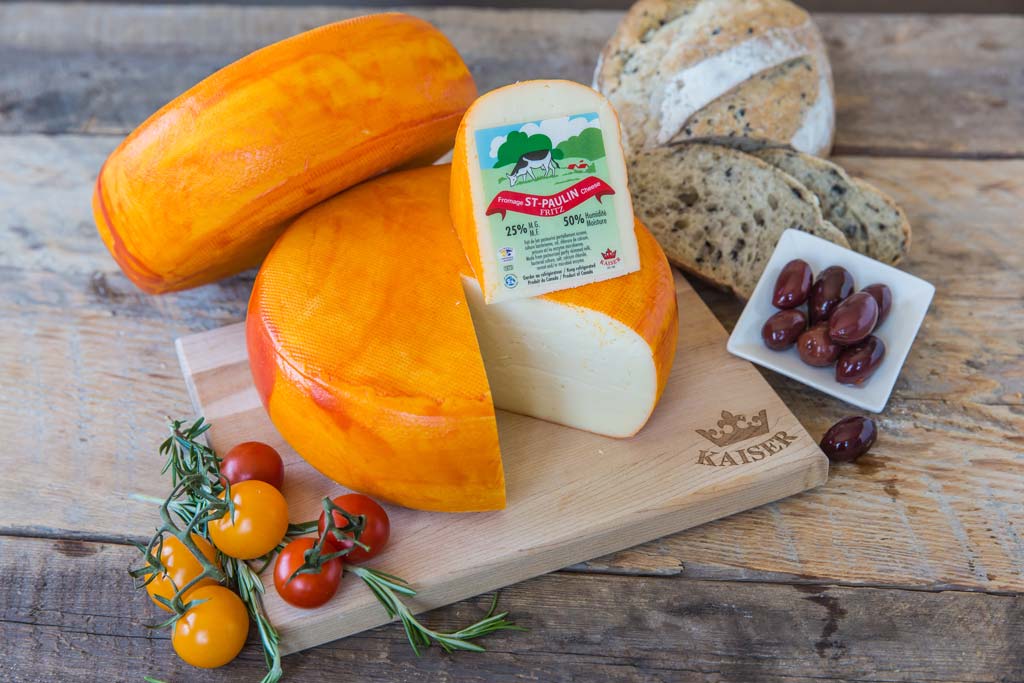What is Saint Paulin? France’s Monastic Cheese

Welcome to the world of French cheese, where each variety has a story as rich and complex as its flavor. Among these, Saint Paulin stands out – a true testament to France’s monastic traditions. This semi-soft, creamy delight was originally crafted by Trappist monks and is named after the monastery’s founder, Saint Paulin.
Distinguished by its bright orange rind and mild, slightly sweet taste, Saint Paulin cheese is a culinary heritage that beautifully encapsulates the serenity and dedication of monastic life.
Quick Facts About Saint Paulin Cheese
| Quick Fact | Details |
|---|---|
| Origin | France |
| Type | Semi-soft, pasteurized, cow’s milk cheese. |
| Taste | Mild, slightly sweet, and nutty flavor. |
| Texture | Creamy and supple texture. |
| Color | Its interior is pale yellow with an orangish edible rind. |
| Aging | Typically ages over a period of 4-6 weeks. |
| Pairing | Pairs well with fresh fruits, breads, and light wines. |
| History | Originally made by Trappist monks. |
| Serving | Makes a good table cheese and also used in cooking. |
| Storage | Store it in a refrigerator, ideally between 35-45°F. |
| Nutrition | Rich in protein and calcium, but also high in fat. |
| Availability | Generally available year-round in most places. |
| Substitute | Havarti or Monterey Jack can be used as substitutes. |
What is Saint Paulin Cheese

Saint Paulin cheese, a culinary gem from France, is a semi-soft, creamy delight that originated from the diligent hands of Trappist monks. This pasteurized cow’s milk cheese carries a mild, slightly sweet and nutty flavor that can captivate any palate. Its texture is a creamy and supple treat, with a pale yellow interior beautifully contrasted by an orangish edible rind.
Originally produced at Saint Paulin, this cheese has a rich history steeped in monastic traditions. It shares a familial bond with the iconic Port Salut cheese, known for its vibrant exterior and traditional cheesemaking techniques. Saint Paulin stands as a testament to the richness of summer’s bounty, expressing itself through its creamy flavor and smooth texture.
But what sets Saint Paulin apart is its versatility. This cheese is not only a delightful addition to any cheese platter but also shines in various culinary applications. Whether you’re enjoying it with fresh fruits and light wines or incorporating it into your favorite recipes, Saint Paulin brings a touch of French heritage to your table.
As a semi-hard uncooked pressed cheese, Saint Paulin averages around 4.4 lbs in weight. It’s akin to the likes of Havarti and Esrom, offering a unique alternative for cheese lovers. And with its smooth brioche and buttery taste, it’s a delicately flavored fine cheese that truly encapsulates the Northwestern Terroir.
Whether you’re a seasoned cheese connoisseur or a curious foodie, exploring the world of Saint Paulin cheese promises to be an adventure in taste and tradition. So next time you’re looking for a new cheese to try, remember Saint Paulin – a creamy, mild, and incredibly versatile choice that brings a piece of French culinary heritage right to your kitchen.
What Does Saint Paulin Cheese Taste Like?
Saint Paulin cheese is renowned for its mild, slightly sweet, and somewhat nutty flavor. It has a unique taste that is neither too strong nor too bland, making it a versatile cheese suitable for various culinary uses. The creaminess of the cheese balances the subtle flavors beautifully, creating a smooth, buttery mouthfeel.
As it ages, the sweetness gives way to a more nuanced, savory flavor profile. Its delicate taste makes it a fantastic addition to cheese platters, sandwiches, and even in cooking, where it can add a touch of creamy richness without overpowering other ingredients.
Saint Paulin Cheese Tasting Notes
- Flavor: Saint Paulin cheese carries a mild, slightly sweet, and somewhat nutty flavor.
- Aroma: It has a subtle, pleasant aroma, not too strong nor too pungent.
- Texture: The cheese features a creamy and supple texture that is smooth on the palate.
- Color: Its interior is a pale yellow, contrasted beautifully by an orangish edible rind.
- Aftertaste: The aftertaste is mildly sweet and lingers subtly, leaving a pleasant finish.
- Mouthfeel: Due to its creaminess, it offers a buttery mouthfeel, melting smoothly on the tongue.
- Strength: It’s a mild cheese, not too overpowering, making it suitable for various culinary uses.
- Age: The flavor profile deepens slightly with age, becoming more savory while maintaining its characteristic sweetness.
How to Eat Saint Paulin Cheese?
- Cheese Platter: Include Saint Paulin in your cheese platter for a mild, creamy option. Pair it with fresh fruits like grapes or figs and a variety of crackers.
- Cooking: Use this versatile cheese in cooking. It melts beautifully, making it perfect for gratins, soups, sauces, or melted over vegetables.
- Sandwiches: Add Saint Paulin to your sandwiches. Its mild flavor and creamy texture make it a great addition to both cold and hot sandwiches.
- Wine Pairing: Pair Saint Paulin with light wines like Sauvignon Blanc or a fruity Beaujolais. The wine’s acidity and fruitiness complement the cheese’s creamy, nutty flavor.
- Dessert: Try Saint Paulin cheese as a dessert cheese. Pair it with a sweet jam or honey for a delightful end to your meal.
- Breakfast: Incorporate it into your breakfast by spreading it on freshly baked bread or bagels.
- Grilled Cheese: Elevate your grilled cheese sandwich by adding slices of Saint Paulin for a luxurious, creamy melt.
- Cheese Fondue: Include Saint Paulin in your cheese fondue mix for added creaminess and a delicate, sweet note.
10 Best Saint Paulin Cheese Substitutes
| Substitute | Description |
|---|---|
| Havarti | A Danish cheese with a creamy texture and mild, slightly sweet flavor similar to Saint Paulin. |
| Monterey Jack | An American cheese known for its mild flavor and smooth, creamy texture. It melts well, making it a good substitute in cooking. |
| Gouda | A Dutch cheese with a slightly sweet, nutty flavor that can mimic the taste of Saint Paulin. Young Gouda has a similar texture too. |
| Colby | Another mild, creamy cheese from America. It’s slightly more tangy but can work as a substitute in most recipes. |
| Muenster | This semi-soft cheese has a very mild flavor and melts well, making it a good option for sandwiches or cooking. |
| Emmental | A Swiss cheese with a slightly sweet, nutty flavor. It’s a bit firmer but can work as a substitute in certain dishes. |
| Fontina | An Italian cheese with a mild, slightly nutty flavor. It’s creamier than Saint Paulin but works well in recipes requiring melted cheese. |
| Maasdam | A Dutch cheese that’s sweet and nutty, similar to Saint Paulin. It has large holes, so it’s not as creamy but works well in sandwiches. |
| Butterkase | A German cheese with a buttery texture and mild flavor. It’s a good substitute for Saint Paulin in sandwiches or on a cheese board. |
| Edam | Another Dutch cheese with a slightly sweet, nutty flavor. It’s firmer than Saint Paulin but can be used as a substitute in many recipes. |
What Pairs Well With Saint Paulin Cheese?

Food that goes well with Saint Paulin Cheese:
| Category | Food Items |
|---|---|
| Fruit | Apples, Pears, Grapes, Figs, Apricots |
| Bread/Crackers | Baguette, Rye Bread, Whole Grain Crackers, Water Biscuits |
| Meats | Prosciutto, Salami, Smoked Ham, Roast Beef |
| Nuts/Seeds | Almonds, Walnuts, Sunflower Seeds, Pumpkin Seeds |
| Vegetables | Cherry Tomatoes, Bell Peppers, Cucumbers, Olives |
| Condiments/Jams | Honey, Fig Jam, Apricot Preserve, Dijon Mustard |
| Desserts/Sweets | Dark Chocolate, Milk Chocolate, Caramel, Shortbread Cookies |
| Herbs/Spices | Basil, Rosemary, Black Pepper, Thyme |
| Other Cheeses | Camembert, Brie, Roquefort, Comté |
Also read: What Fruit Goes on a Charcuterie Board?
Beverage that goes well with Saint Paulin Cheese:
| Category | Beverage Items |
|---|---|
| White Wine | Sauvignon Blanc, Chardonnay, Riesling |
| Red Wine | Beaujolais, Pinot Noir, Merlot |
| Beer | Belgian Ale, Wheat Beer, Lager |
| Cider | Dry Apple Cider, Pear Cider |
| Non-Alcoholic | Sparkling Water, Apple Juice, Grape Juice |
| Spirits/Liquors | Brandy, Whiskey, Port |
Also read: Best Wine and Cheese Pairings: The Ultimate Guide
Also read:
- What is Saint Albray? France’s Unique Floral Cheese
- What is Idiazabal? A Taste of the Basque Country
- What is Bûcheron? France’s Versatile Goat Cheese
- What is Merlot Bellavitano? The Perfect Union of Wine and Cheese
- What is Lagrein? The Italian Cheese Washed in Wine
- What is Leerdammer? A Dutch Cheese Classic
- What is Brusselse Kaas? Belgium’s Unique Cheese





